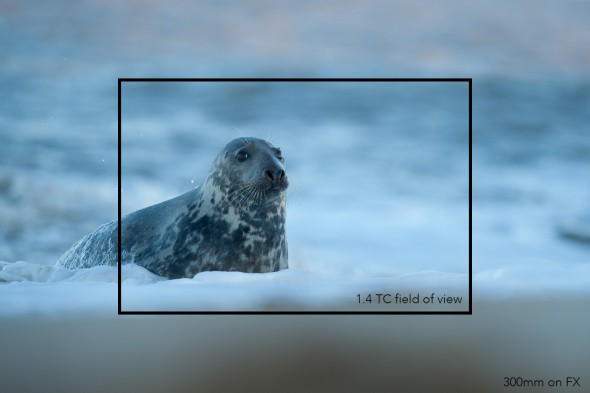You can push your long lenses even longer with a teleconverter, but it pays to know what you’re doing first. Tom Mason runs through the basics of teleconverters.

TCs are a great way of getting you closer to the action when it’s impossible to do so physically. Here is an angle-of-view comparison between a 300mm lens on an FX-format camera, and that of the same lens with the 1.4x teleconverter added on.
When I am speaking to photographers out in the field, one subject that comes up time and time again is the use of teleconverters for long-lens photography. These handy little devices can be a godsend when working out on location.
As with all things in photography, it’s not necessarily that simple, so before you go ahead and purchase one of these handy accessories there are a few things you should certainly consider…
So, How Do They Work?
Often I hear people talking about teleconverters and how they ‘increase the focal length’ of a given lens. In reality, however, this is not the case. A teleconverter, or TC, does not in any way increase the ‘mm’ length of a lens, but instead simply magnifies the image that is already being produced, in much the same way that holding a magnifying glass over piece of paper will cause the writing on it to appear closer.
In use, they are positioned between the camera and the lens and so increase the apparent focal length of the lens optically, thus effectively increasing the lens’ magnification before the image is recorded onto the sensor. For this gain in apparent focal length there are a number of tradeoffs, I’ll cover more of these later, but an important one to note first is that the lens’ widest aperture will drop by one to two stops when a TC is in use.
A quick side note: When using a teleconverter, it is best to attach it to the lens before the camera, as this makes it far easier to connect. When the time comes to remove it, most feature a locking pin that needs to be depressed in order to detach the extender from the lens.

Teleconverters have the added advantage of not increasing the minimum focusing distance of a given lens, meaning they can be utilised when working with smaller subjects such as butterflies.
Compatibility
Now, before we all get too excited about the prospect of longer telephoto reach, it is important to take a look at the compatibility of teleconverters with various lenses and cameras.
Due to the way TCs work (being positioned between a camera and lens) some combinations don’t allow for them to be used. This can be due to a number of factors, however the most common is an extended rear lens element preventing the TC from connecting. For most consumer lenses, it is a consistently the case that TCs cannot be used. The lenses people often ask about are the 70-300mm or 55-200mm lenses, and sadly none of these can take a TC.
Lists of compatible lenses and cameras are available on both Nikon’s and Canon’s websites, but as a general rule, lenses that are most accommodating of teleconverters are the more professional-grade lenses with constant apertures. Common focal lengths that will take a TC include the 70-200mm f/2.8 or f/4; the 80-400mm and 100-400mm f/4.5-5.5; the 300mm f/2.8 and f/4; and then, of course, the more extravagant pro-quality super telephotos.
When looking at your camera, it is important to consider what apertures the focusing system can work with. When a TC is added to a lens such as the 100-400mm, the maximum aperture will drop from f5.6 to f8 and this can result in some cameras no longer being able to autofocus. Modern AF systems in the higher-end bodies may retain auto features, but the number of focusing points may be reduced, even as far as down to the single central point.
If you have any questions or worries about compatibility it is always worth checking. Often compatibility charts can be found online, or of course you can ring the Wex team who will be more than happy to answer your query.

When crawling across fields, lugging a 500mm or 600mm prime isn’t always practical. A 300mm with a 1.4x TC makes for a much more compact package with a similar effective focal range.
The range
As with all photographic accessories there is a range of options to choose from in the teleconverter market. Own-brand and third-party options are available, however most photographers will stick to their own brand for maximum image quality and compatibility.
Teleconverters come in a range of magnifications, with the most common being 1.4x or 2.0x (Nikon also produces a 1.7x). A 1.4x TC will reduce the aperture of a lens by a single stop, whilst a 2.0x will reduce it by two.
So, for example, on a 300mm f/2.8 lens a 1.4x TC will give the apparent focal length of 420mm at f/4, whilst a 2.0x will give the apparent view of a 600mm at f/5.6.
Most commonly, photographers will invest in the 1.4x variant due to them offering the best compromise over aperture, image quality and focus speed. However a 2x can be great for squeezing some extra reach when it is needed.
Tradeoffs
As with all things in life, there are a number of tradeoffs when using teleconverters. There’s not just the reduction in aperture, but also a few other things to think about.
1. Sharpness and IQ
With the addition of extra optical elements, sharpness in the resulting images when a TC is used can be affected. In real-world use, the effects of a 1.4x TC when used in conjunction with a high quality lens are barely noticeable, even wide open. The 2.0x TC results in a marginal reduction in sharpness, though stopping down to f8 results in a marked improvement.
I use my 1.4x all the time and never worry about a loss of sharpness, even on the megapixel monster that is the Nikon D810. It is important to remember that a TC will amplify the flaws of any given lens, so if a lens already suffers from reduced sharpness when wide open, or from chromatic aberrations, such effects will only be exaggerated by the addition of a TC.

When you want to fill the frame yet not get too close and disturb your subject, a TC will allow you to increase your magnification whilst helping you maintain a respectful working distance.
2. Focus speed
With modern autofocus systems improving all of the time, focusing speed when using a teleconverter has undergone a marked improvement in the last few years. With a pro-quality body and lens, I see very little reduction in focusing speed when a 1.4x TC is used in normal conditions, and the same for a 2.0x in good light.
When the light levels start to drop off, the 2.0x can start to become increasingly sluggish and does miss focus more often. So removing it as the light levels fade would certainly be advised. Of course focusing speed is not just dependent on the addition of the TC; the better the autofocus system in your camera (and lens), the more accurate and snappy the results will be. On my 300mm f/2.8 lens I very rarely encounter a problem, and even when I had the older 300mm f/4 AF-S the 1.4x always performed excellently.
When the light does start to fade, to maximise your chances and improve the speed of focus be sure to make the most of features such as focus limiters and pre-focusing to capitalise on speed.
3. Camera shake
The increased apparent focal length caused by the magnification of a TC also means that stability becomes a more pressing issue. Camera-shake can come into play and so using a sturdy support, be it a tripod or beanbag, is necessary for getting those ultra-sharp images.
Personally my simple rule around shutter speeds for telephoto lenses is to always try and work with a shutter speed twice that of my current focal length, so for a 300mm that would be 1/640sec, and for a 500mm it’d go up to 1/1000sec. This ensures sharper results.
TC vs cropping?
In the modern age of high-megapixel sensors, some people say TCs are needed less and less. With a 36MP sensor it is easy to crop a 1.5x magnification and still keep a very usable 16MP file. This has the added benefit of reducing the number of optical elements involved, resulting in greater sharpness as well as maintaining the larger original aperture of the lens.
However, if you still need the greater magnification, or work with shy and elusive subjects, TCs offer a great way of getting those frame-filling shots. And there’s no reason not to combine techniques – cropping an image that’s already been shot with a TC can give some excellent pulling power and reduce the need for carrying multiple telephoto lenses!

When working with small birds sometimes you need the extra magnification, and a 2.0x TC can deliver excellent results when stopped down.
Final thoughts
Teleconverters can provide an excellent way of getting some additional reach from your lenses, provided they are compatible. The 1.4x variants have very little in the way of downsides, and can be used without hesitation in all but the worst light. The 2.0x variants have their place when ultra-high magnifications are needed, but with modern cameras, the use of a 1.4x and a judicious crop should provide more than enough in terms of both magnification and image quality.
I always have my 1.4x TC in the bag and wouldn’t be without it. Sometimes it’s just the perfect tool for gaining that little bit extra magnification for frame filling shots!
About the Author
Tom Mason is a wildlife photographer and journalist, and is also the host of our Life in the Wild series. Keep up with him on Twitter, @TomMasonPhoto, or visit his website for more.

